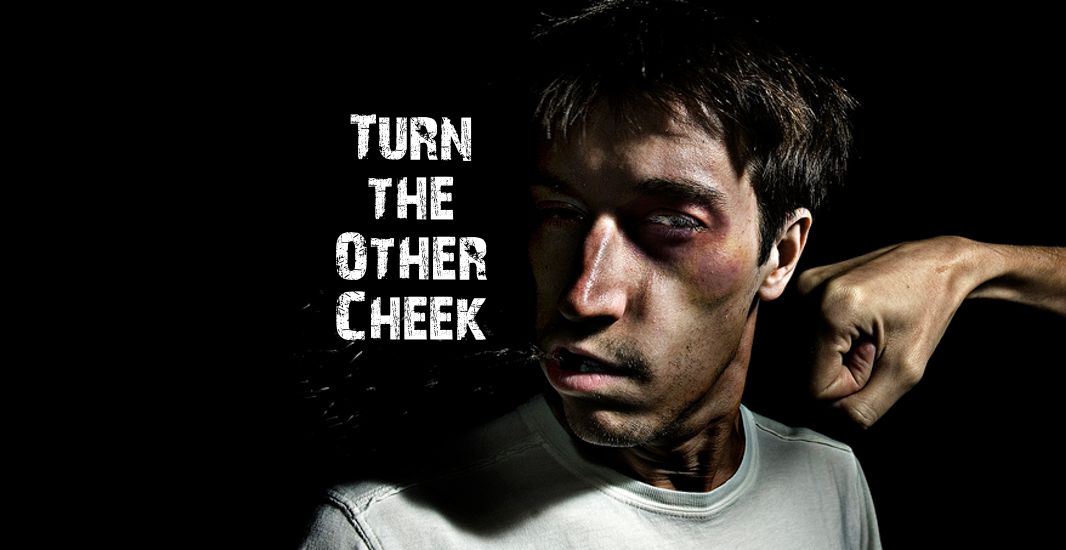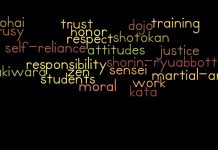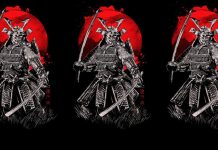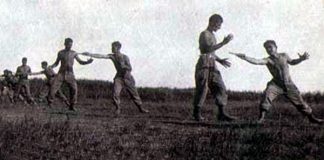As a Christian martial artist, I am often asked two questions regarding my martial arts study and my faith. From non-believers (those who do not follow “Biblical Christianity”) I am asked how I reconcile the apparent conflict between martial arts training and Christ’s admonition to turn the other cheek. My Christian friends want to know how I reconcile my Christian beliefs and the religious, philosophical, mystical, and metaphysical aspects of the art. The first question reveals the general misunderstanding of Christ’s teachings so common among nonbelievers. The second reveals a similar lack of understanding on the Christian’s part.
Although the “turning the other cheek” question is raised most often by my non-Christian friends, it is just as misunderstood by my Christian brothers and sisters. Since Christians have the most difficulty with these issues I will address them from the Christian perspective using frequent biblical references and examples. We will begin with what was for me the tougher of the two questions.
TO TURN OR NOT TO TURN
A brochure from a martial arts publishing firm described well what most of the world believes about Christian participation in the martial arts. It said, “Kung-fu teaches that turning the other cheek to those whose ways of life are set in strength and violence is wrong. Such a passive attitude encourages lawlessness and injustice.”
The suggestion is that those who believe in “turning the other cheek” believe in voluntarily accepting violence and injustice. Further, such a position is considered wrong and contrary to the philosophy of kung-fu. Since the idea of “turning the other cheek” is from the Bible, are we to believe that there is a conflict between Christian teaching and the study of martial arts? Is the Christian attitude toward physical violence to be a passive one? The essential question is whether there is ever justification for inflicting injury, or even death, on another human being. That is the primary issue because other issues like pacifism, the morality of war, capital punishment and the like, are actually derivatives or corollaries of that primary issue.(1)
The idea of turning the other cheek, if not one of the more difficult teachings of Jesus to understand, is certainly one of the more difficult ones to observe — providing it is to be taken without qualification. From the gospel of Matthew, Chapter 5, verses 38 and 39, we read the following:
You have heard that it was said, “An eye for an eye, and a tooth for a tooth.” But I say to you, do not resist one who is evil. But if anyone strikes you on the right cheek, turn to him the other also.
There are two ways one can interpret the command to turn the other cheek. The first is to interpret the text literally, asserting that it means exactly what it says. That would impose a duty of nonresistance on all men in all circumstances. One cannot, however, require the literal acceptance of verse 38 without also requiring the same of the other verses in that chapter — such as verses 29 and 30. Verse 29 reads, “… if your right eye causes you to sin, pluck it out,” and verse 30 adds, “… if your right hand causes you sin, cut it off.” Taking these verses literally, without qualification, could quickly lead one to institutionalized confinement! No. This literal, unqualified interpretation seems untenable.
The other way to interpret the text is to say that it means exactly what it says, but with an understood reservation for those cases that everyone would naturally assume to be exceptions. For example, when I tell my children to be good, I do not have to tell them all of what that includes — i.e., don’t burn down the house, don’t put the neighbor’s car in the lake, and so on. Those things are understood. This is a normal interpretation. C. S. Lewis, a popular Christian theologian, put it like this:
Does anyone suppose that our Lord’s hearers understood him to mean that if a homicidal maniac, attempting to murder a third party, tried to knock me out of the way, I must stand aside and let him get his victim? I think it impossible that they could have so understood him. I believe the meaning of the words was perfectly clear — insofar as you are simply an angry man who has been hurt, mortify your anger and do not strike back. If however, your motives are other than egoistic retaliation, then not only are you free to protect yourself and others, rather it is your responsibility to do so.(2)
Can we find any scripture or biblical examples that confirm this? Yes. Look at Jesus’ life. Jesus lived what he preached. He never returned evil for evil; he never retaliated (although he possessed the wherewithal to do so), but did he always “turn the other cheek?” In at least one case, he did not.(3)
The 18th chapter of John’s gospel records Jesus’ arrest and trial before both the Jewish and Roman courts. In verse 22 of that chapter, Jesus is struck with the palm of the hand by one of the officers of the Jewish religious court for answering the high priest in what the officer thought was a disrespectful manner. In verse 23 Jesus responded, “If I have spoken wrongly, bear witness of the wrong; but if rightly, why do you strike Me?”
The officer could have struck him anywhere, but a slap across the face is a common response to disrespectful speech. Assuming that Jesus was slapped across the face, we find no evidence of his voluntarily offering his other cheek for more. On the contrary, he asks why he deserved such unjust treatment.
In the book of Acts, Chapter 16, we find that the apostle Paul took a similar stand. After being beaten and cast into prison unjustly, the Philippian magistrates decided that they would release Paul and his companions and forget the matter. To this Paul responded as follows in verse 37:
They have beaten us publicly, uncondemned, men who are Roman citizens, and have thrown us into prison; and do they now cast us out secretly? No! Let them come themselves and take us out.
Clearly, Paul accepted no such injustice. This refutes the literal interpretation and supports the normal interpretation. The actions of Jesus and his apostle Paul indicate that there are times when the believer can and should resist evil and not offer the other cheek.
The scriptures contain still other examples that support this. Paul, writing in the first epistle to Timothy, Chapter 5, verse 8 charges me, as a husband and father, with the following responsibility: “If any one does not provide for his relatives, and especially for his own family, he has disowned the faith and is worse than an unbeliever.”
Provision means more than just food, shelter, and clothing. It also includes safety, security, and protection from harm. Jesus, when telling his followers that they should always be ready for his return, illustrated his point by saying that his return would be as a “thief in the night”; that is, unexpected. In Matthew 24, verse 43, he added, “But know this, that if the householder had known in what part of the night the thief was coming, he would have watched and not have let his house to be broken into.”
While this verse refers directly to believers being ever ready for the Lord’s return, it also clearly demonstrates that a man was rightfully expected to defend his home and family from harm. There is one more, lesser known, verse we should look at. In the moments before Christ’s arrest in the garden the following exchange took place between Jesus and his disciples:
When I sent you out with no purse or bag or sandals, did you lack anything? They said, “Nothing.” He said to them, But now, let him who has a purse take it, and likewise a bag. And let him who has no sword sell his mantle and buy one. (Luke 22:35-36)
Moments later, as Jesus is arrested; Peter uses his sword to defend his master. In John’s gospel, Chapter 18, verses 10 and 11 it is recorded as follows:
Then Simon Peter, having a sword, drew it and struck the high priest’s slave and cut off his right ear. The slave’s name was Malchus. Jesus said unto Peter, “Put up your sword in its sheath; shall I not drink the cup which the Father has given me?”
Do these two accounts conflict? No. In the first account the Lord was telling his disciples that the time was coming when they would no longer receive hospitality and would have to provide for themselves including self-protection (the need for the sword). This does not conflict with John’s account, because there Jesus does not tell Peter to get rid of his sword, but to put it in its sheath. The sword was, and still is, necessary. There, in the garden, however, it was being used counter to Christ’s purpose.
On the basis of Christ’s teachings, is there really a conflict between Christian teaching and the study of martial arts? No. Is the Christian attitude toward physical violence to be a passive one? Again, the answer is no.
RELIGIOUS INFLUENCES
Discussions about turning the other cheek” focus on the question of Christian participation in martial arts in general. What about participation in Asian martial arts? Questions about how Christians handle the philosophical and religious aspects of the art usually focus on certain practices common to various traditional martial arts schools. However, before addressing specific questions, some background and history are necessary. We need to know what philosophical or religious aspects are inherent in Asian martial arts, why they are taught, and whether they are necessary for training.
Today, a number of people devote their lives to martial arts study primarily for reasons of self-development. Through their practice of the martial arts, they seek to attain some glimpse of the “wisdom of the East” as set forth in the various philosophies of Taoism, Buddhism, and Zen. Karate-do, for example, means the way of karate. It is a journey which begins with the physical and ends with the spirit. The goal is to develop the spirit. How? Through physical karate training. This parallels the path of hatha-yoga with its goal self-purification through physical application.
The incorporation of the contemplative, meditative, or philosophical aspects into the martial arts may have evolved as teachers began to see a need for morality in the art. As practitioners became increasingly capable of destruction, some form of control — some personal means of tempering physical conduct and actions — became necessary. Hence, moral codes like the Japanese code of bushido evolved.
For some, then, the martial arts offer a way that they hope will provide them with the wisdom to understand both themselves and the often unintelligible world in which they live. What they seek is a philosophy of life, a code to live by, a discipline — in an otherwise undisciplined world.
For the Christian, using martial arts study for spiritual self-development fails for two reasons. First, from a practical standpoint, there are a variety of other avenues available to the individual wishing to study Eastern culture, thought, or philosophy to formulate a life credo (and without having to break a sweat doing it, either). Second, and more importantly, Asian martial arts philosophy is deeply entwined in Eastern mysticism and religion. As such, it is incompatible with Christian beliefs. However the philosophical and religious aspects of the martial arts are not necessary for developing the physical skills the martial arts student is seeking.
Target shooting is, for many, an enjoyable pastime, but it is not without its dangers. Awareness and care are necessary to prevent injury. The same is true of everything we do, be it driving a car, cooking, using power tools — even watching television. Martial arts are no different. Christians must be aware of the inherent dangers in the study of Eastern martial arts; but that does not necessarily mean abstinence from physical martial arts training.
The Christian martial artist must remove the religious overtones that are frequently taught as part of Eastern martial arts. Instead, he should concentrate on skills that enhance mental concentration, improve sensitivity to differing degrees of threat, and increase awareness of the interaction between attitude and performance. This is learning the fine art of strategic thinking.
Meditation
Specifically, the question I am most often asked concerns the practice of meditation. What does the Christian do when asked to meditate? First, the believer need not back away from meditation. There is nothing inherently wrong with meditation.
Scripture abounds with passages admonishing the believer to meditate on the Lord, meditate on his law, meditate on his promises, and meditate on his Word. Thus, when told to use class time to meditate, the Christian can do so. Not necessarily on what the instructor tells him to meditate on (if he tells him anything). Not with the aim of emptying his mind (as in Zen mushin) or looking within for some mystic power (such as centering in Transcendental Meditation), but purposefully and productively busying it – focusing it outward and upward to the Creator God.
Throughout history, Christian symbols and quotations from the Bible have been manipulated and abused by many including the occult, hate groups; even the news media. Should we abstain from displaying a cross because some hate group uses a burning cross to legitimize its actions? Should we avoid those verses from the Bible that have been misinterpreted, twisted, and perverted by those who would use them to serve their own purposes? No! Dr. Walter Martin, founder of Christian Research Institute, probably said it best. “The believer,” he said, “should not surrender the tools of light to anyone simply because others have abused them and perverted their meaning.”(4)
Alternatively, if the Christian is not feeling particularly spiritual during karate class, he can meditate on the techniques he is learning. Because of its use by New Age groups, visualization has been given an undeserved bad reputation. But using imagination to train physical skills does not violate biblical principles. So the Christian martial artist can use meditation time to rehearse what you were learning; mentally practice; see yourself having a great workout. Again, use meditation to focus your mind and attention in a positive and productive way.
Bowing
Another question that arises from time to time refers to the practice of bowing. In many schools, everyone bows before entering or leaving the training area. This is done as a sign of respect for a place of learning. In most schools, the students and instructors bow to each other. In some schools, there is even bowing before the American flag (and sometimes before the flag of the country from which the art or the instructor immigrated as well). Finally, there are schools where it is customary to bow before a school shrine or altar. What are we as Christian martial artists to make of these customs?
Historically, bowing has been used to demonstrate an attitude of respect, reverence, and submission. In Oriental culture it is common for people to prostrate themselves on the ground before kings and princes. Such customs were also prevalent among the Hebrews.
However, bowing is just as frequently noticed in scripture as an act of religious homage. No mention is made of posture, so we have no clear instruction as to whether it is of any significance if someone bows with his face to the ground (a common Eastern practice) or simply bows from the waist. This issue is not addressed because it is unimportant. It is not the posture that counts but the purpose.
Bowing, as an act of religious homage is addressed extensively in the Bible, and there is no doubt that bowing before any idol, spiritual leader or guide, or representative of a false god is prohibited. Joshua, in his last words to the elders of Israel said the following:
Do not associate with these nations that remain among you; do not invoke the names of their gods or swear by them. You must not serve them or bow down to them: (Joshua 23:7)
This theme is repeated throughout scripture, so it is clear that bowing as an act of religious or spiritual homage is prohibited.
So serious is this matter that the godly man finds even innocent association with such an act painful to his conscience. For example, Naaman is cleansed of his leprosy by God through His prophet Elisha. A highly regarded general of the king of Syria, Naaman says afterward that he will never again make burnt offerings and sacrifices to any other god save the Lord. However, he still has one problem. His master, the king of Syria, still worships his own god. The Syrian king was old and often took Naaman with him to lean on his arm when he went to worship. Naaman’s words to Elisha reflect his predicament. Consider the following passage:
But may the LORD forgive your servant for this one thing: When my master enters the temple of Rimmon to bow down and he is leaning on my arm and I bow also — when I bow down in the temple of Rimmon, may the LORD forgive your servant for this. “Go in peace,” Elisha said. (2 Kings 5:18-19)
Again, Naaman, was not worshiping this Syrian deity; his master was. He was not bowing down before Rimmon. He was only providing physical support for his master. However, Naaman found even this association was uncomfortable.
What seems clear from all of this is that the act of bowing itself is not the problem. Rather, it is the purpose of such an act. Biblically, bowing before lawful authority and spiritual leaders (like the kings and prophets) was an accepted practice. For that reason alone I think one would be hard pressed to convince an Englishman he should not bow before his monarch.
As for bowing before a school altar or shrine, if it is done as an act of obeisance or homage to some spiritual leader or guide, then for the Christian, the practice is prohibited and he must excuse himself from participation. If that is not possible (the bowing is required), then he should seek instruction elsewhere. There are many good schools where a Christian can train without having to involve himself in such practice.
Suppose that bowing before the school shrine is simply a cultural tradition, a sign of respect for a place of learning, or just recognition of the efforts of past teachers — without any religious or spiritual significance. Is that all right?
Every believer must answer that question for himself. The apostle Paul, in I Corinthians, Chapter 10, verse 23, makes it clear that “all things are lawful,” but at the same time, he says, all things are not “expedient.” There may be cultural standards to consider. For example, in our culture, drinking alcoholic beverages of any kind is generally frowned upon by many bible-believing Christians. However, our Christian brothers in Germany would not consider ordering a soft drink or iced tea with their meals. The Christian, then, must balance biblical truth with social standards, asking himself: Is it lawful? Is it expedient? If, in clear conscience before God, you can answer both of those questions affirmatively, then go ahead and participate.
In our school the only bowing we do is a type of mutual salute to begin and end our classes. It is not a bow of submission, obeisance, or homage. Rather, it is like an officer returning the salute of an enlisted man. With the words “Attention” and “Salute,” the teacher shows his respect for the students — they honor him by choosing to study and train with him. The students, in return, show their respect for the teacher as a worthy instructor and fellow student. It is, quite simply, mutual respect.
Finally, those who would tell us to separate ourselves from the study of Asian martial arts because of the general religious influences and overtones inherent there would do well to consider Christmas. Christmas is not held on Christ’s birthday, but on the birthday of the sun. (December 25 was the first day after the winter solstice that the ancients could tell the days were getting longer.) The Christmas tree, the boughs of holly, the Christmas wreath, and the Yule log are all pagan traditions (and these are only a few). With that in mind, should not our response to the Christmas celebration likewise be abstention? No. As with everything we do in life, awareness and understanding are the keys.
CONCLUSION
The study and practice of martial arts, including Asian martial arts, offer the discerning believer an enjoyable alternative to conventional, and often boring, exercise programs. Further, they are a practical means of providing security for family, self, and home. If they are approached as outlined above, I find nothing in them that conflicts with Christian beliefs or Biblical truth.
Notes and References
- While the scope of this paper is limited to addressing the question of how a Christian reconciles the biblical principle of “turning the other cheek” with participation in the martial arts, the answers given here have direct bearing on resolution of the primary issue and, to some degree, the satellite issues as well.
- C. S. Lewis, The Weight of Glory and Other Addresses. (New York: Macmillan Publishing Co., Inc. 1980), 49-50.
- The fact that Christ was capable of resisting evil is important. A man of peace is not one who is incapable of resisting evil. Claiming to be a man of peace when incapable of resisting evil is merely compliance. Accepting evil, on the other hand, when one is fully capable of resisting or returning it is the true mark of a man of peace.
- Moody Monthly Magazine, December: 1986.
This article is reproduced with the permission of Bob Orlando. Please contact him at Bob@OrlandoKuntao.com or visit his web site http://www.orlandokuntao.com/






